
Scipio Africanus Jones was an American educator, lawyer, judge, philanthropist, and Republican politician from the state of Arkansas. He was most known for having guided the appeals of the twelve African-American men condemned to death after the Elaine Race Riot of October 1919. More than one hundred African Americans were indicted in the aftermath of the riot, although an estimated one hundred to two hundred Black Americans were killed in the county, along with five whites. No whites were prosecuted by the state. The case was appealed to the United States Supreme Court, which in Moore v. Dempsey (1923) set a precedent of reviewing the conduct of state criminal trials against the Due Process Clause of the Fourteenth Amendment to the United States Constitution.

Little Rock National Cemetery is a United States National Cemetery, located two miles (3 km) south of the city of Little Rock, in Pulaski County, Arkansas. It encompasses 31.7 acres (12.8 ha), and as of the end of 2005, had 25,172 interments. Administered by the United States Department of Veterans Affairs, it is currently closed to new interments.
The Mosaic Templars Cultural Center is a Division of Arkansas Heritage museum in Little Rock, Arkansas, United States. Its mission is to collect, preserve, interpret and celebrate African American history, culture and community in Arkansas from 1870 to the present, and to inform and educate the public about Black achievements, especially in business, politics and the arts.

Little Rock is the capital and most populous city of the U.S. state of Arkansas. As the county seat of Pulaski County, the city was incorporated on November 7, 1831, on the south bank of the Arkansas River close to the state's geographic center. The city derived its name from a rock formation along the river, named the "Little Rock" by the French explorer Jean-Baptiste Bénard de la Harpe in the 1720s. The capital of the Arkansas Territory was moved to Little Rock from Arkansas Post in 1821. The city's population was 197,312 in 2019 according to the United States Census Bureau. The six-county Little Rock-North Little Rock-Conway, AR Metropolitan Statistical Area (MSA) is ranked 78th in terms of population in the United States with 738,344 residents according to the 2017 estimate by the United States Census Bureau.

The Lincoln American Tower is a 22-story building located at the corner of North Main and Court streets in Memphis, Tennessee. It is also a historical landmark, one of the first steel frame skyscrapers built in Memphis. The tower underwent a six-year refurbishing project starting in 2002, and despite a fire in 2006, is now open and accepting tenants.

George Richard Mann was a United States architect, trained at MIT, whose designs included the Arkansas State Capitol. He was the leading architect in Arkansas from 1900 until 1930, and his designs were among the finalists in competitions for the capitols of several other states.

The Masonic Temple is a historic fraternal and commercial building at East Fourth Avenue and State Street in Pine Bluff, Arkansas. Fundraising for the building was led by Joseph Carter Corbin and J. N. Donohoo. It is a four-story brick building, built between 1902 and 1904 by the state's African-American Masonic lodge, the Sovereign Grand Lodge of Free and Accepted Masons. It was at the time Pine Bluff's tallest building. The ground floor held retail space, the second floor professional offices, and the upper floors were devoted to the Masonic organizations.
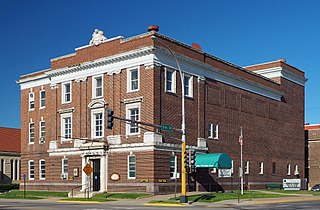
The Winona Masonic Temple is a historic Masonic Temple in Winona, Minnesota, United States, completed in 1909. Many local civic and business leaders were members of the lodge. Containing a large ballroom and other meeting space, the building was an important venue in Winona for both Masonic activities and general public events. The Winona Masonic Temple was listed on the National Register of Historic Places in 1998 for having state-level significance in the themes of art and social history. It was nominated as the headquarters of a fraternal organization important to Winona's civic and social development, and for containing Minnesota's largest collection of Masonic theatre backdrops and stage equipment.
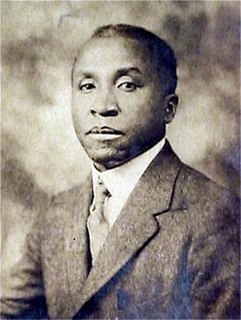
Walter Thomas Bailey was an American architect from Kewanee, Illinois. He was the first African American graduate with a bachelor of science degree in architectural engineering from the University of Illinois at Urbana-Champaign and the first licensed African-American architect in the state of Illinois. He worked at the Tuskegee Institute, and practiced in both Memphis and Chicago. Walter T. Bailey became the second African American that graduated from the University of Illinois.
The following is a timeline of the history of the city of Little Rock, Arkansas, USA.
The Department of Arkansas Heritage (DAH) is a department of the U.S. State of Arkansas responsible for preserving, promoting and protecting Arkansas's natural and cultural history and heritage. The department consists of eight separate divisions: four heritage museums and four heritage resource agencies. The department’s central office coordinates and promotes all division efforts to make information and materials about the state readily accessible to all Arkansans through heritage and cultural events, educational resources and special publications. The common goal of all divisions is to seek out and protect the legacy and lore of Arkansas and what distinguishes it from other states.
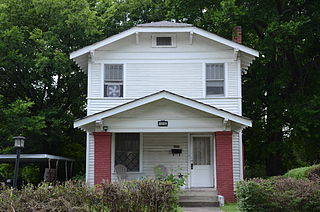
The Henderson House is a historic house at 1510 South Ringo Street in Little Rock, Arkansas. It is a two-story wood-frame structure with Craftsman styling, built in 1925 for Benjamin D. Henderson. Henderson was a prominent figure in Little Rock's African-American community, holding positions of importance in the Mosaic Templars of America, an African-American Masonic society. It is one of the finer houses in the Dunbar School neighborhood, a historically African-American area.

The Oakland-Fraternal Cemetery is a historic cemetery on Barber Street in Little Rock, Arkansas. It actually consists of six originally separate cemeteries, and lies adjacent to the Little Rock National Cemetery, of which it was once a part. Portions of the cemetery are dedicated to Confederate war dead, and its grounds include two separate Jewish cemeteries, and the Fraternal Cemetery, a burying ground for African Americans. The cemetery, listed on the National Register of Historic Places in 2010, continues in active use.
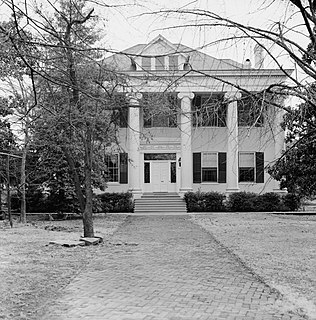
The Pike–Fletcher–Terry House, also known as just the Terry Mansion and now the Community Gallery at the Terry House, is a historic house at 8th and Rock Streets in central Little Rock, Arkansas. It is a large two-story Greek Revival building, whose grounds occupy the western end of a city block bounded by Rock, 8th, and 7th Streets. Its most prominent feature is its north-facing six-column Greek temple portico. The house was built in 1840 for Albert Pike, a leading figure in Arkansas' territorial and early state history. It has also been home to John Fletcher, a prominent Little Rock businessman and American Civil War veteran, and David D. Terry, Fletcher's son-in-law and also a prominent Arkansas politician. It was then home to prominent philanthropist and political activist Adolphine Fletcher Terry. She and her sister Mary Fletcher Drennan willed the family mansion to the city, for use by the nearby Arkansas Art Center. It has been a municipal building since 1964. It served as the Arkansas Decorative Arts Center from 1985 to 2003. it is now used by the Art Center as an event space and gallery.

Originally known as Taborian Temple, the building was constructed in 1916 by the Arkansas chapter of the Knights and Daughters of Tabor when the 9th street area of Little Rock, Arkansas was a major hub of African-American commerce.

John M. Lewellen was an American politician. He was elected and served on the Little Rock City Board of Directors, the Pulaski County Quorum Court and in the Arkansas State Legislature representing the district in which he resided. He was a member of the Arkansas House of Representatives from 1999 to 2004, when he was succeeded by his wife, Wilhelmina Lewellen who served until 2010. John Lewellen is the only Arkansas official to have been elected and represented his district on the city, county and state level.
The Mosaic Templars of America was a black fraternal order founded by John E. Bush and Chester W. Keatts, two former slaves, in Little Rock, Arkansas, in 1883. The organization originally provided illness, death, and burial insurance during an era when few basic services were available to black people.
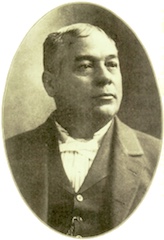
Chester W. Keatts (1854–1908), a former slave, co-founded the Mosaic Templars of America in Little Rock, Arkansas. He worked for the railway mail service, federal court, and as a lawman. He campaigned for two offices as a member of the Republican Party and initially received the majority of votes, but was not formally elected due to ballot interference by the Democrats.

The Arkansas Teachers Association Headquarters Building and Professional Services Building are a pair of historic commercial buildings at 1304 and 1306 Wright Street in Little Rock, Arkansas. Occupying adjacent lots with a shared parking area and landscaping, the two buildings are both single-story brick structures, designed by George Tschiemer & Associates and built in the early 1960s. The buildings were listed as a pair on the National Register of Historic Places in 2018, for the role of the Arkansas Teachers Association, an association of African-American educators, in its work during the Civil Rights Era of the 1960s to end segregation in the state.

















